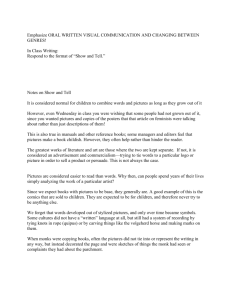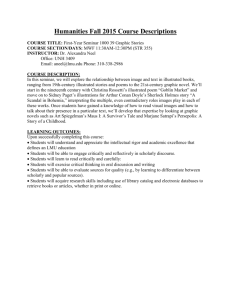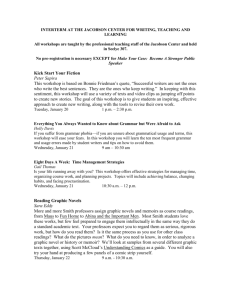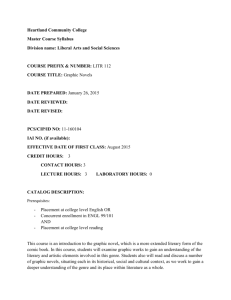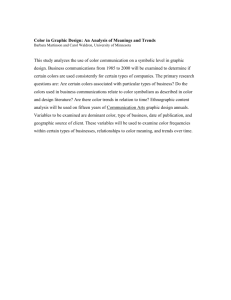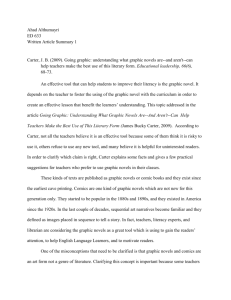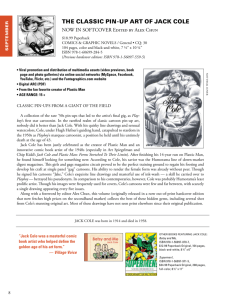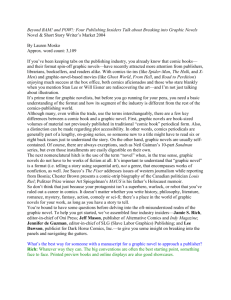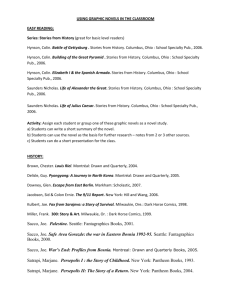The Graphic Novel: Literature Lite? Winter 2006
advertisement
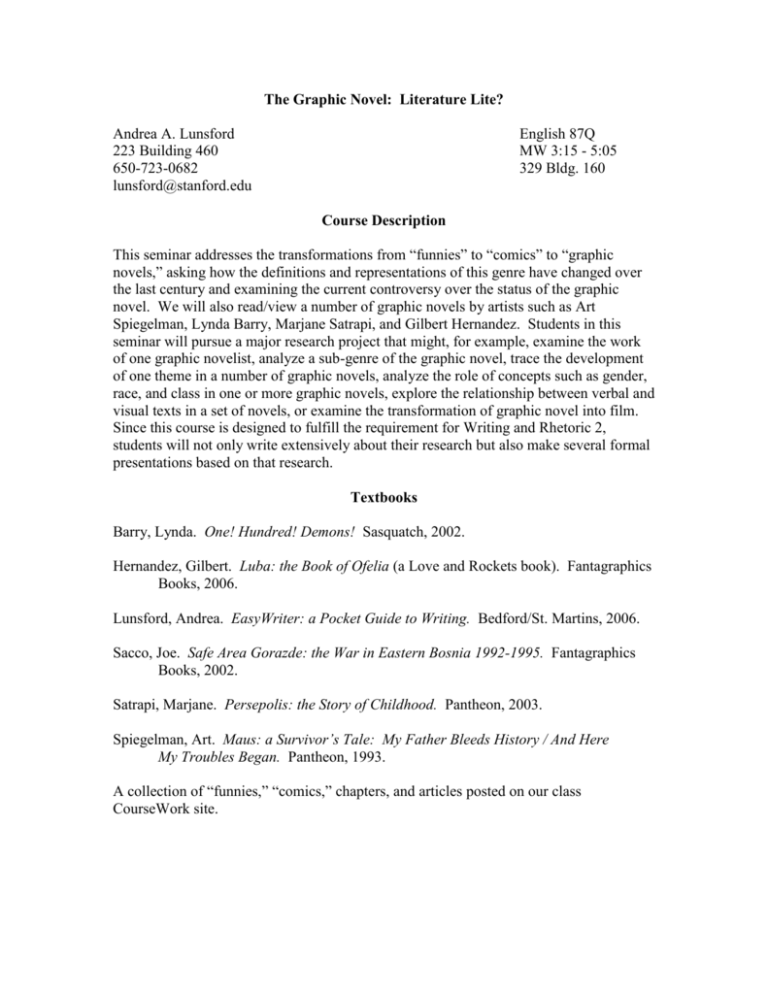
The Graphic Novel: Literature Lite? Andrea A. Lunsford 223 Building 460 650-723-0682 lunsford@stanford.edu English 87Q MW 3:15 - 5:05 329 Bldg. 160 Course Description This seminar addresses the transformations from “funnies” to “comics” to “graphic novels,” asking how the definitions and representations of this genre have changed over the last century and examining the current controversy over the status of the graphic novel. We will also read/view a number of graphic novels by artists such as Art Spiegelman, Lynda Barry, Marjane Satrapi, and Gilbert Hernandez. Students in this seminar will pursue a major research project that might, for example, examine the work of one graphic novelist, analyze a sub-genre of the graphic novel, trace the development of one theme in a number of graphic novels, analyze the role of concepts such as gender, race, and class in one or more graphic novels, explore the relationship between verbal and visual texts in a set of novels, or examine the transformation of graphic novel into film. Since this course is designed to fulfill the requirement for Writing and Rhetoric 2, students will not only write extensively about their research but also make several formal presentations based on that research. Textbooks Barry, Lynda. One! Hundred! Demons! Sasquatch, 2002. Hernandez, Gilbert. Luba: the Book of Ofelia (a Love and Rockets book). Fantagraphics Books, 2006. Lunsford, Andrea. EasyWriter: a Pocket Guide to Writing. Bedford/St. Martins, 2006. Sacco, Joe. Safe Area Gorazde: the War in Eastern Bosnia 1992-1995. Fantagraphics Books, 2002. Satrapi, Marjane. Persepolis: the Story of Childhood. Pantheon, 2003. Spiegelman, Art. Maus: a Survivor’s Tale: My Father Bleeds History / And Here My Troubles Began. Pantheon, 1993. A collection of “funnies,” “comics,” chapters, and articles posted on our class CourseWork site. Assignments Overall, you can expect to write about 20 to 25 pages of revised text for this class along with 15 to 20 minutes of formal class presentations. To begin, you’ll create a research question related to the graphic novel tradition and develop it into a research proposal you will present to the class (a 2-page script and 5-minute oral presentation) Your next assignment will be to write a 10- to 12-page research-based argument growing out of your proposal. For the third assignment, you will begin with the draft of your researched argument and then decide how best to “translate” it into another medium: an extensive power-point presentation, a Website, an audio essay, and so on. As you make these decisions, you will explore strategies of delivery across media and mode, articulating which medium or media will be most effective in reaching a particular audience with your research. You will then make a 10-minute presentation of your “translated” research (for which you’ll develop an oral script of about 5 pages. Your final written assignment will be a reflective essay on what you have learned about choosing the best genre and medium in which to present research. And last, you’ll make a 3- to 5-minute presentation based on your reflective essay (again, for which you’ll prepare an oral script). Class Schedule Week One: January 11 Where does the graphic novel come from? Preliminary research proposals drafted Practice sessions for proposal presentations set up Week Two: January 16 Martin Luther King Day: no classes January 18 Research proposal presentations Classic “funnies” and “comics” – from media library Week Three: First conferences January 23 Classic “funnies” and “comics,” continued Some ground rules for graphic novels Visit to Special Collections Draft of research project due January 25 Revision workshop Are graphic novels “literature”? Excerpt from Scott McCloud’s Understanding Comics: question—are comics a genre, a medium, or a language? Week Four: January 30 Art Spiegelman, Maus, volumes 1 and 2 February 1 Joe Sacco and comics journalism: Safe Area Gorazde: the War in Eastern Bosnia 1992-1995 Revised research-based argument due In-class workshop on “translating” from one medium to another Week Five: Second conferences February 6 Gilbert Hernandez, Luba: the Book of Ofelia February 8 The making of a comic or graphic novel: how you can use the language of the comics. Week Six: February 13 Marjane Satrapi. Persepolis: the Story of Childhood. A taste of Eurocomics: see CourseWork site February 15 Draft of “translations” due Practice sessions for presentations set up Revision workshop Week Seven: February 20 Presidents’ Day: no classes February 22 Presentation of “translations” Week Eight: February 27 Presentation of “translations” March 1 Special topic to be chosen by class: TBA Week Nine: Third conferences March 6 Draft of reflective essay due Revision workshop March 8 Lynda Barry, One! Hundred! Demons! Week Ten: March 13 Revised reflective essay due Presentations of reflections March 15 The future of graphic novels (Webcomics? Manga? Minicomics?)
